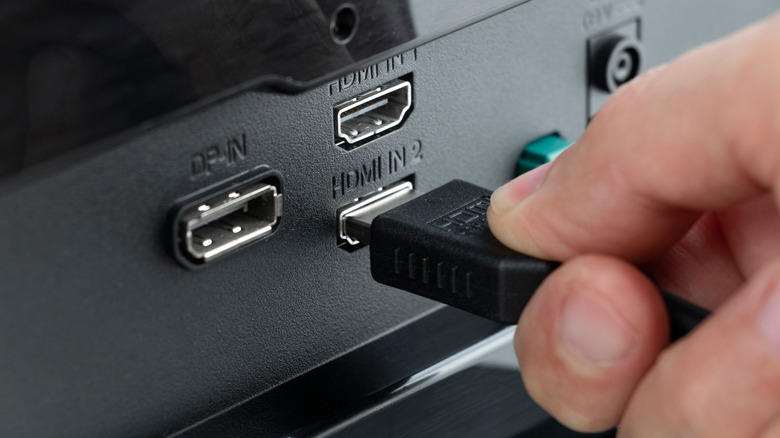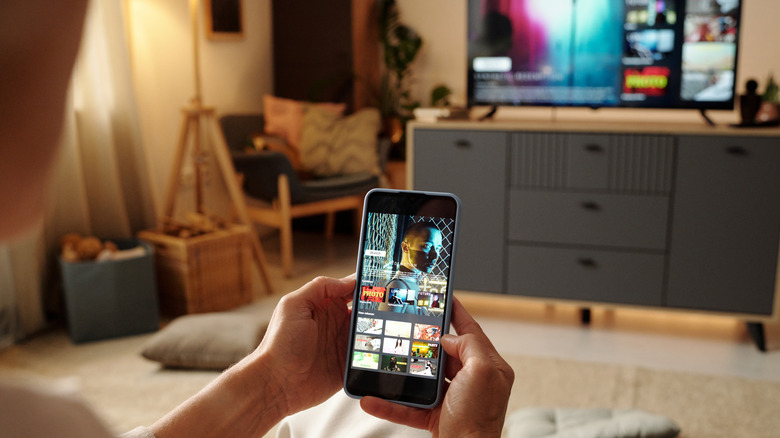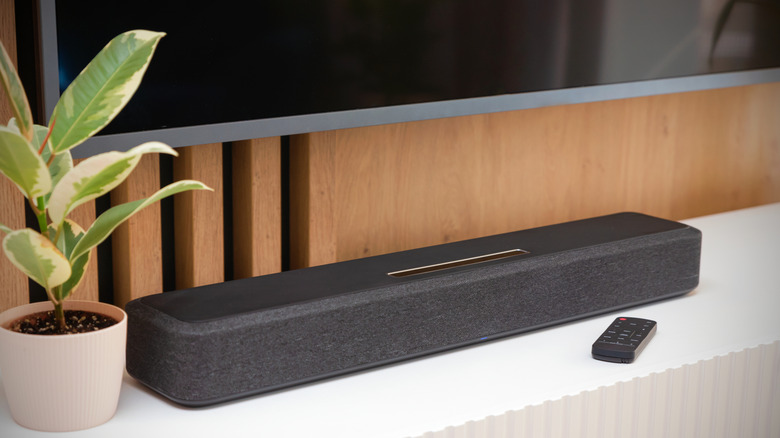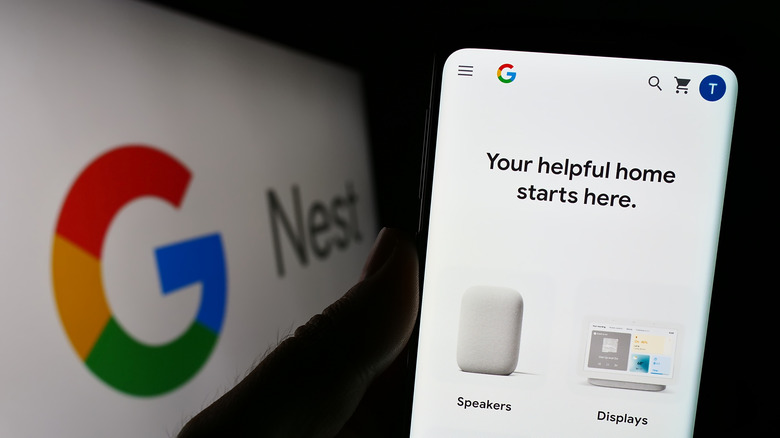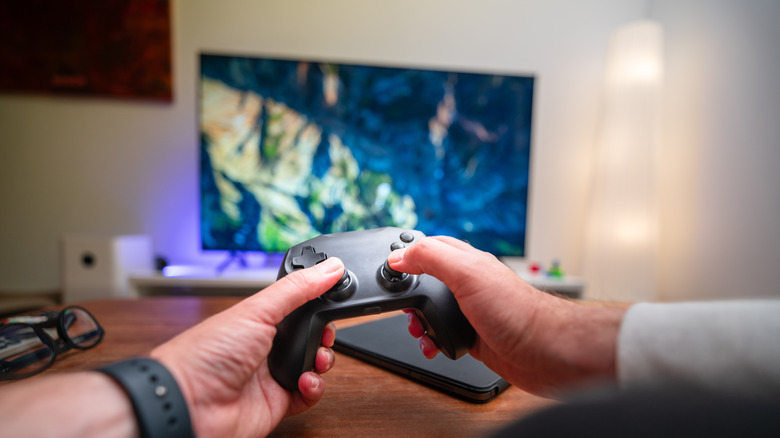5 Devices You Can Connect To Your Smart TV Without Needing HDMI
For some of us, we can remember a time when setting up anything with your TV screen may require a few minutes of fumbling around with cables. Because of this, a lot of us have had to be creative with all the ways we've tried to hide our TV wires, like using raceways, strategically placed decor and so on.
After all, cables can be serious eyesores for people who want aesthetically pleasing environments to come home to at the end of a long day. Among these cables is one of the most longstanding connection systems that have been crucial to modern smart TVs: HDMI. In fact, the HDMI connecting system so important that, not only does it continue to be part of the arsenal of most modern TVs, but there are now different types of HDMI optimized for certain display functions.
However, just because your TV still has an HDMI port, it doesn't mean you always have to use it. A lot of people don't mind sacrificing some quality, and they don't mind experiencing a little more latency for the sake of not having to deal with wires forever. These days, a growing number of TV manufacturers have found ways to circumvent the need for HDMI through things like Bluetooth or Wi-Fi streaming. Here are a few devices that let you connect to your smart TV that don't need HDMI to function.
Laptops
There was a time in tech when chunky laptops shipped with HDMI ports, since it was so essential for sharing things on bigger screens like TVs. With time, thinner models became the standard, and many manufacturers ditched the HDMI port. While it did start a trend of forcing everyone to buy dongles, it also came with advances with wireless streaming technology, such as Apple's AirPlay.
Since then, it has become quite straightforward for a lot of laptops to display wireless with a single screen. While different laptop manufacturers might call it different things, they essentially use Wi-Fi to stream content via your device to the TV.
That said, streaming technology isn't perfect and can be affected by things like distance to the TV, surrounding materials, and Wi-Fi signal quality. While there are things you can do to troubleshoot AirPlay issues, there are times that it's just not worth the risk. Because of this, many people will still opt for wired connections via HDMI, even if they have the option to do it wirelessly.
In professional settings, this is common practice, since it makes the connection more stable, especially if you're working with fluctuating internet speeds. Alternatively, there are situations wherein you'll have no choice but to use HDMI, such as when you're planning to display across multiple screens. For example, you might be hosting a big party where one TV just isn't enough to cover all the action.
Smartphones
While some people settle with sending screenshots, this isn't always possible. For example, if they're using vanish mode on Instagram, it might lead to awkward notifications. Alternatively, you may want to display the latest tea on a much larger screen, like your TV, and scroll through it together. Similar to laptops, you can use your smartphone to both mirror and cast things to your television screen.
While people tend to use the terms interchangeably, there are some key differences between both types of display methods, including how content is optimized for viewing. It's important to note that there are still times that either option may not work for your needs, and it has everything to do with software compatibility.
Since smart TVs have been around for quite some time, it's possible that the ones in your home are still running on hardware that is not built to handle the latest streaming technology. Because of this, it still merits having an HDMI cable adapter, in case you want another way to share your phone screen.
On the other hand, if you are an iPhone user with a TV that doesn't have AirPlay built-in, not all hope is lost. There are solutions like the Apple TV, which adds AirPlay to older smart TVs via HDMI. Apart from giving your old smart TV new life, the Apple tvOS also has a ton of other cool features like Enhance Dialogue and Live Captions.
Sound systems
A big part of enjoying movies or TV shows is the audio that comes with it. While most smart TVs already come with their own built-in speakers, a lot of watchers think it's worth investing in external ones. In the past, this often meant hooking up your TV to the speakers via things like auxiliary jacks, RCA cables, and even special HDMI ARC cables.
For people who don't like the messy look of these wires, many modern smart TVs let you use Bluetooth connections with speakers instead. Regardless of your budget, there are tons of Bluetooth speakers worth buying, which add another layer of immersion to your TV viewing experience. For example, there are relatively affordable speaker options from brands such as Anker and JBL, as well as higher end models from the likes of Bose, Sonos, and Marshall.
Should you want to utilize the full depth of what your speakers can do, we've mentioned how powerful the HDMI eARC port can be. Although it generally looks the same as an ordinary HDMI port, the eARC port is specifically designed to maximize your audio experience in several ways, including reduced latency and lowered compression.
If you've spent a pretty penny on your home theater set up, it merits still using HDMI to get both better quality audio, and not to mention, it can give you more access to a slew of Dolby Atmos features, which you can't really get with the typical Bluetooth connection.
Smart hubs and assistants
In a world where connectivity can be a game changer for managing your life, smart assistants can make having a home more fun and less work. With so many smart hubs available on the market, you're spoiled for choice. The best part? They don't even need to be connected to your TV with an HDMI cable to make it do cool things. Apart from the standard Bluetooth and Wi-Fi connection, some smart hubs and assistants also work with protocols like Zigbee or Z-Wave.
With the right set up, smart home integration with your TV can be as simple as being able to turn it on and set it to launch your favorite streaming site with just a single voice command. You can even make it work as part of your routines — for example, you can create scenes for your daily routine, like your TV turning on the news while the curtains are being drawn and your coffee is being brewed.
If you don't want to get a smart hub separately, the good news is you can turn your smart TV into a smart hub, too. Depending on your preferred smart home ecosystem, this might entail downloading a few new apps, but you might also find something with a built-in smart home app, like the many Android TVs that come with the Google Home app. Similarly, many new Samsung smart TVs also have SmartThings ready to use with compatible devices.
Gaming consoles
For some gamers, it's common to have memories of untangling all kinds of wires, whether it's the ones that link your controller to your console, or the AV cable that hooks up the console to your TV. While you'll still have to use cables if you plan to get a retro console, fans of newer consoles have more connection options. Although some popular gaming consoles still use HDMI cables, like the PlayStation 4 & 5, Xbox Series, and Nintendo Switch (via dock), there are now ways to bypass them.
For example, if you download the Steam Link app to your smart TV, you can stream games from your Steam Deck without a USB-C to HDMI adapter or the dock. In the same vein, one of the cool things your PS5 can do includes being able to stream games via the PS5 Remote Play app as long as the unit is in sleep mode and connected to the internet.
Additionally, there's also platforms like Xbox Cloud Gaming, which works directly with some smart TVs without needing a console at all. That being said, you'll still need to invest in an Xbox Game Pass subscription to make it work. If you love playing those multi-player games with your gang, even your giant TV may feel small when it's split a couple of ways. As we've mentioned before, you can have a little more space with the right HDMI splitter.
